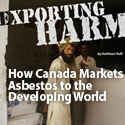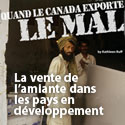Kathleen Ruff, RightOnCanada.ca
The asbestos industry has money. But money cannot buy scientific credibility
The asbestos industry will be holding a conference in New Delhi, India on December 3 & 4 to promote use of asbestos in India. The International Chrysotile Association (ICA), an organisation financed by the asbestos industry and which promotes the industry’s interests, is organizing the conference.
The ICA has now put on its website a list of its speakers and summaries of their pro-asbestos presentations.
The purpose of the conference and of the ICA is to promote continued use of chrysotile asbestos, particularly in India, the biggest importer of asbestos in the world. Scientists and health experts around the world have condemned the asbestos industry and its allies for disseminating deadly, deceptive misinformation that will cause disease and loss of life.
Many of the speakers have been paid by the asbestos industry for years to take part in activities and events to promote use of chrysotile asbestos, particularly in developing countries. They form a small, notorious group of asbestos industry allies.
David Bernstein, for example, has received millions of dollars from asbestos lobby organisations for research on rats which, according to Bernstein, shows that rats positively enjoy being exposed to chrysotile asbestos. A New York court recently concluded that a number of scientific articles published by Bernstein were not, in reality, independent science, but were controlled by the asbestos industry and constituted potential crime-fraud. Dr. Bagatin’s research has been financed by the asbestos industry in Brazil. Dr. Dunnigan is a former employee of the Chrysotile Institute, an asbestos lobby organisation in Canada. In 2012, Dr. Bernstein, Dr. Dunnigan, Dr. Bagatin and Dr. Hesterberg were all witnesses in front of the Supreme Court of Brazil to argue on behalf of the Brazilian asbestos lobby against a proposed ban on asbestos.
Dr. Kashansky is an employee of a Russian government institution and, not surprisingly, he promotes the position of his employer, the government of Russia. Russia is by far the biggest producer and exporter of asbestos in the world and the Russian government is determined to do whatever is necessary to protect the profits it makes by exporting vast amounts of asbestos. If Dr. Kashansky spoke up and opposed the Russian government’s pro-asbestos position, he would be committing career suicide or worse. Not a single scientist in Russia has dared to oppose their government’s pro-asbestos position.
The pro-asbestos views put forward by these scientists are rejected by independent scientists as having no credibility. Not a single reputable scientific body in the world supports their position.
But they are very popular with the asbestos industry, which has money to pay them to show up again and again at asbestos industry events, such as the one in India, to help sell asbestos and to defeat proposed bans on asbestos.
While the asbestos industry has money to defend its financial interest, those who will be harmed, as a result, and who will die painful, unnecessary deaths from asbestos-related diseases, have no money to defend their interest, which is life itself.
SCIENTISTS SPEAKING AT ASBESTOS INDUSTRY CONFERENCE
01. BAGATIN, Dr. Ericson (Brazil)
02. BASANETS, Dr. Anzhela V. (Ukraine)
03. BERNSTEIN, Dr. David (Switzerland)
04. BOVORNKITTI, Dr. Somchai (Thailand)
05. DUNNIGAN, Dr. Jacques (Canada)
06. HANG, Dr. Le Thi (Vietnam)
07. HESTERBERG, Dr. Thomas W. (USA)
08. HOSKINS, Dr. John Anthony (UK)
09. KASHANSKY, Dr. Sergey Vladimirovich (Russia)
10. KITAMURA, Dr. Satoshi (Brazil)
11. NOLAN, Dr. Robert (USA)
12. TIWARI, Dr. Rajnarayan Ramshankar (India)
13. VISHVANATHAN, Mr. H. (India)



One Response to “Scientists who help asbestos industry sell asbestos”
Trackbacks/Pingbacks
[…] The North American Insulation Manufacturers’ Association (NAIMA) suffered a major setback in 1994, when its attempt to block inclusion of man-made mineral fibres (MMMF) in the US National Toxicology Program’s Annual Report of Carcinogens (ARC) failed. NAIMA has submitted a petition to the Secretary of Human Services opposing the move. In response, scientists with the federation workplace safety regulator OSHA reviewed the evidence. They were critical of evidence used in the company’s defence, particularly industry sponsored animal studies by Thomas Hesterberg which concluded glass fibres do not cause cancer. The OSHA scientists highlighted several major deficiencies in the Hesterberg animal experiments, and also contested the negative conclusions reached. Following its review of both animal and human data, they concluded that glass fibres should be classified as carcinogenic, noting “that on a fiber-per-fiber basis, glass fibers may be as potent or even more potent than asbestos.” The NAIMA petition was denied and glass fibre was listed in the ARC as being “reasonably anticipated to cause cancer in humans.” Thomas Hesterberg later turned his attention to the asbestos industry and gave evidence against an asbestos ban before the Supreme Court in Brazil in 2012 and was a contributor at an asbestos industry promotional conference in India in 2013. In November 2013, he was named in a list of “scientists who help asbestos industry sell asbestos.” […]